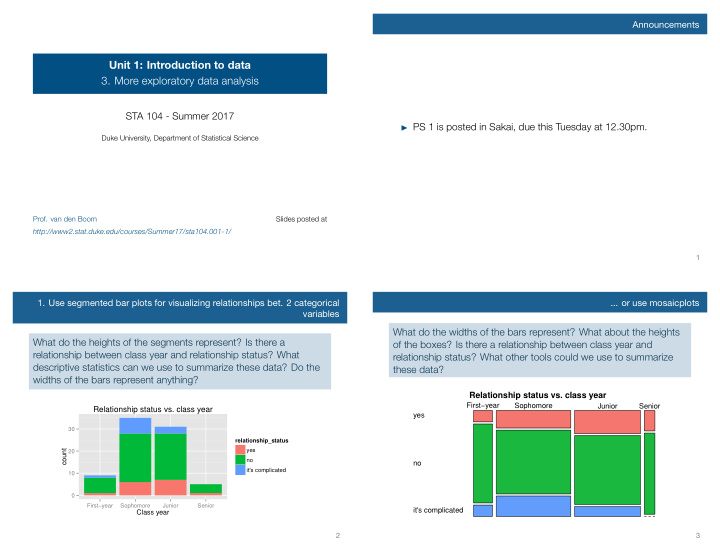



Announcements Unit 1: Introduction to data 3. More exploratory data analysis STA 104 - Summer 2017 ▶ PS 1 is posted in Sakai, due this Tuesday at 12.30pm. Duke University, Department of Statistical Science Prof. van den Boom Slides posted at http://www2.stat.duke.edu/courses/Summer17/sta104.001-1/ 1 1. Use segmented bar plots for visualizing relationships bet. 2 categorical ... or use mosaicplots variables What do the widths of the bars represent? What about the heights What do the heights of the segments represent? Is there a of the boxes? Is there a relationship between class year and relationship between class year and relationship status? What relationship status? What other tools could we use to summarize descriptive statistics can we use to summarize these data? Do the these data? widths of the bars represent anything? Relationship status vs. class year First−year Sophomore Junior Senior Relationship status vs. class year yes 30 relationship_status count yes 20 no no it's complicated 10 0 First−year Sophomore Junior Senior it's complicated Class year 2 3
2. Use side-by-side box plots to visualize relationships between a numerical 3. Not all observed differences are statistically significant and categorical variable How do drinking habits of vegetarian vs. non-vegetarian students compare? Nights drinking/week vs. vegetarianism 6 ● What percent of the students sitting in the left side of the classroom have Mac computers? What about on the right? Are these numbers ● nights drinking exactly the same? If not, do you think the difference is real, or due to 4 random chance? 2 0 no yes vegetarian 4 5 Race and death-penalty sentences in Florida murder cases Another look A 1991 study by Radelet and Pierce on race and death-penalty (DP) sentences gives the following table: Same data, taking into consideration victim’s race: Defendant’s race DP No DP Total % DP Victim’s race Defendant’s race DP No DP Total % DP Caucasian 53 430 483 Caucasian Caucasian 53 414 467 African American 15 176 191 Caucasian African American 11 37 48 Total 68 606 674 African American Caucasian 0 16 16 African American African American 4 139 143 Who is more likely to get the death penalty? Total 68 606 674 Who is more likely to get the death penalty? Adapted from Subsection 2.3.2 of A. Agresti (2002), Categorical Data Analysis, 2nd ed., and http://math.stackexchange.com/questions/83756/examples-of-simpsons-paradox . 6 7
Contradiction? ▶ People of one race are more likely to murder others of the same race, murdering a Caucasian is more likely to result in the death penalty, and there are more Caucasian defendants than African Application exercise: 1.2 Histogram to boxplot American defendants in the sample. ▶ Controlling for the victim’s race reveals more insights into the See the course website for instructions. data, and changes the direction of the relationship between race and death penalty. ▶ This phenomenon is called Simpson’s Paradox : An association, or a comparison, that holds when we compare two groups can disappear or even be reversed when the original groups are broken down into smaller groups according to some other feature (a confounding/lurking variable). 8 9 Summary of main ideas 1. Use segmented bar plots or mosaic plots for visualizing relationships between two categorical variables 2. Use side-by-side box plots to visualize relationships between a numerical and categorical variable 3. Not all observed differences are statistically significant 4. Be aware of Simpson’s paradox 10
Recommend
More recommend